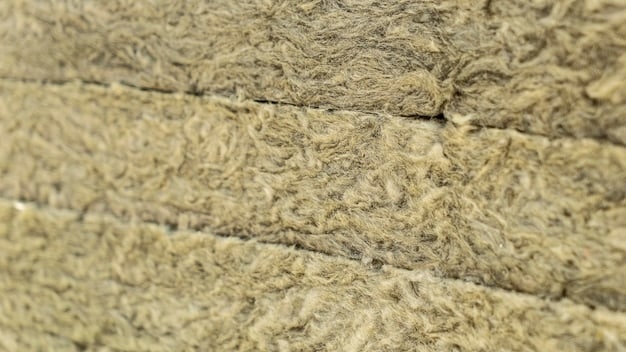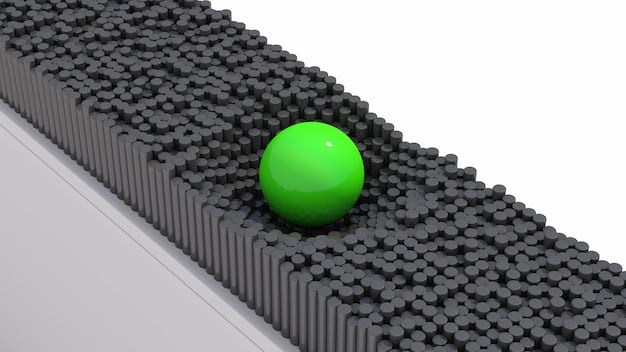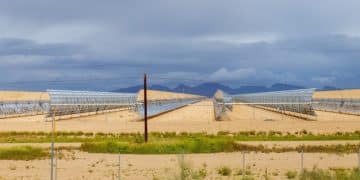Latest Innovations in US Green Building Materials for Sustainable Construction

The latest innovations in US green building materials for sustainable construction include bio-based materials, recycled content products, and advanced insulation techniques, enhancing energy efficiency and reducing environmental impact.
The construction industry in the United States is undergoing a green revolution, driven by the urgent need for sustainable practices. Let’s explore the latest innovations in US green building materials for sustainable construction, revolutionizing how we build and design our homes and cities.
Exploring Eco-Friendly US Building Materials
The surge in demand for sustainable construction has spurred significant innovations in building materials. These eco-friendly alternatives aim to minimize environmental impact while maintaining or even enhancing structural performance.
From bio-based composites to revolutionary concrete mixes, the options are rapidly expanding, providing architects and builders with a diverse palette for creating greener structures.
Bio-Based Building Materials
Bio-based materials are derived from renewable biological sources, offering a compelling alternative to traditional materials.
These materials not only reduce reliance on fossil fuels but also often have lower embodied energy, making them a cornerstone of sustainable building practices.
- Bamboo: Known for its rapid growth and high strength, bamboo is used in flooring, structural components, and decorative elements.
- Mycelium: Grown from mushroom roots, mycelium can be molded into various shapes, offering insulation and structural support.
- Hempcrete: A mixture of hemp fibers, lime, and water, hempcrete provides excellent insulation and is fire-resistant.
These bio-based options are increasingly popular as architects and builders seek genuinely sustainable solutions that also enhance indoor air quality and reduce carbon footprints.

In conclusion, the introduction of innovative bio-based building materials presents a significant shift towards environmentally responsible construction. Materials like bamboo, mycelium, and hempcrete are not only sustainable but also offer unique structural and aesthetic benefits.
Recycled and Reclaimed Construction Materials
Utilizing recycled and reclaimed materials is another key strategy in sustainable construction. These materials divert waste from landfills, reduce the need for new resource extraction, and often come with a compelling narrative of repurposing.
The use of recycled materials conserves resources and lowers the environmental footprint of construction projects.
Recycled Steel and Aluminum
Steel and aluminum are highly recyclable materials, making them excellent choices for green building projects.
Recycling these metals requires significantly less energy than producing them from raw ores, leading to substantial energy savings and reduced greenhouse gas emissions.
- Recycled Steel: Used in structural frameworks, roofing, and reinforcing bars, recycled steel maintains its strength and durability while reducing its environmental impact.
- Recycled Aluminum: Employed in window frames, cladding, and decorative elements, recycled aluminum offers a lightweight and corrosion-resistant option.
- Benefits: Both recycled steel and aluminum contribute points toward LEED certification and other green building standards.
The adoption of recycled steel and aluminum in construction not only cuts down on waste but also drastically reduces energy consumption, thereby supporting a circular economy.
Reclaimed Wood
Reclaimed wood is sourced from old buildings, barns, and other structures, giving it a second life in new construction projects.
This material adds character and uniqueness to designs while preserving forests and reducing the demand for newly harvested timber.
- Applications: Reclaimed wood is used in flooring, paneling, furniture, and decorative beams, offering a warm and rustic aesthetic.
- Benefits: Using reclaimed wood reduces deforestation, lowers carbon emissions, and adds a distinctive, historical element to buildings.
- Sourcing: Reliable suppliers ensure the wood is properly treated and ready for use in modern construction.
Reclaimed wood brings a unique blend of sustainability and aesthetic appeal, adding character to new structures while significantly reducing environmental impact.
In summary, prioritizing recycled and reclaimed materials such as steel, aluminum, and wood is crucial for reducing construction waste and conserving natural resources. These options provide environmental and aesthetic benefits, aligning with sustainable building practices.
Innovative Concrete and Cement Alternatives
Concrete is one of the most widely used building materials globally, but its production is a significant source of carbon emissions. Innovations in concrete technology aim to reduce its environmental impact.
These advancements include using alternative materials and improving production methods to create more sustainable and environmentally friendly concrete options.
Green Concrete
Green concrete incorporates waste materials such as fly ash, slag, and silica fume to reduce the amount of cement needed.
This reduces the carbon footprint of concrete production while maintaining its structural integrity.
- Fly Ash Concrete: Replacing a portion of cement with fly ash, a byproduct of coal combustion, improves workability and durability.
- Slag Concrete: Using slag, a byproduct of steel production, enhances concrete’s resistance to chemical attack and reduces permeability.
- Silica Fume Concrete: Adding silica fume, a byproduct of silicon production, increases concrete’s strength and durability.
The use of green concrete significantly lowers the carbon footprint of construction projects by utilizing waste materials and reducing cement consumption.
Carbon-Capturing Concrete
Carbon-capturing concrete absorbs carbon dioxide from the atmosphere during its production and hardening processes.
This technology effectively turns concrete into a carbon sink, offsetting some of the emissions associated with its manufacture.
- How it Works: The concrete is treated with a process that allows it to absorb CO2, which then becomes chemically bound within the material.
- Environmental Impact: This approach can significantly reduce the overall carbon footprint of concrete structures.
- Companies Leading the Way: Several companies are developing and deploying carbon-capturing concrete technologies.
Carbon-capturing concrete represents a groundbreaking approach to mitigating the environmental impact of construction by transforming a traditionally high-emission material into a carbon storage solution.

In conclusion, the development of green and carbon-capturing concrete alternatives marks a substantial advancement in sustainable construction. By reducing reliance on traditional cement and capturing atmospheric CO2, these innovations significantly lessen the environmental footprint of concrete structures.
High-Performance and Sustainable Insulation
Effective insulation is essential for reducing energy consumption in buildings. Sustainable insulation materials not only minimize energy loss but also use environmentally friendly manufacturing processes and materials.
These materials provide excellent thermal performance while reducing the environmental impact associated with traditional insulation options.
Recycled Denim Insulation
Made from recycled denim scraps, recycled denim insulation offers excellent thermal and acoustic performance.
This innovative material diverts textile waste from landfills and requires less energy to produce than traditional fiberglass insulation.
- Benefits: Recycled denim insulation is formaldehyde-free, fire-resistant, and naturally mold-resistant.
- Applications: It can be used in walls, ceilings, and floors, providing effective insulation in residential and commercial buildings.
- Environmental Impact: Recycling denim reduces waste and lowers the energy needed for manufacturing insulation.
Recycled denim insulation is a creative and effective way to use waste materials while improving building energy efficiency.
Aerogel Insulation
Aerogel is an extremely lightweight and highly effective insulation material made from silica.
It offers superior thermal performance compared to traditional insulation, reducing energy consumption and greenhouse gas emissions.
- Properties: Aerogel is known for its low thermal conductivity, high durability, and resistance to moisture.
- Applications: It can be used in walls, roofs, and windows, providing exceptional insulation in various climates.
- Sustainability: While the production process can be energy-intensive, the long-term energy savings offset the initial environmental impact.
Aerogel insulation represents a cutting-edge solution for achieving high energy efficiency in buildings, especially in extreme climates.
In summary, sustainable insulation materials like recycled denim and aerogel are instrumental in decreasing a building’s energy usage and environmental impact. These options offer effective thermal performance along with eco-friendly attributes.
Advancements in Sustainable Roofing Materials
The roof plays a critical role in protecting a building from the elements. Sustainable roofing materials minimize environmental impact and improve energy efficiency.
Innovative roofing solutions are designed to reduce energy consumption, lower carbon footprints, and enhance building resilience.
Cool Roofs
Cool roofs are designed to reflect sunlight and absorb less heat than traditional roofs.
This reduces the building’s cooling load and mitigates the urban heat island effect.
- Materials: Cool roofs can be made from reflective coatings, light-colored materials, or specialized membranes.
- Benefits: They lower energy consumption, reduce greenhouse gas emissions, and improve occupant comfort.
- Applications: Cool roofs are suitable for both residential and commercial buildings, especially in warm climates.
Cool roofs offer an effective and straightforward way to reduce energy costs and environmental impact.
Green Roofs
Green roofs are covered with vegetation, providing insulation, reducing stormwater runoff, and improving air quality.
They also create habitats for wildlife and enhance the aesthetic appeal of buildings.
- Types: Green roofs can be extensive (shallow soil layer) or intensive (deeper soil layer with a wider variety of plants).
- Benefits: They reduce energy consumption, manage stormwater runoff, improve air quality, and enhance biodiversity.
- Implementation: Proper planning and maintenance are essential for the long-term success of a green roof.
Green roofs offer a host of environmental and economic benefits, making them a valuable asset for sustainable buildings.
To summarize, sustainable roofing options such as cool and green roofs offer critical benefits from improved energy efficiency and stormwater management to enhanced biodiversity. These innovations create more environmentally friendly and resilient buildings.
Smart Building Technologies and Material Integration
Integrating smart building technologies with sustainable materials optimizes resource use and enhances overall building performance. These technologies provide real-time data and automated control to improve energy efficiency and reduce waste.
This integration creates adaptive, responsive buildings that minimize environmental impact and maximize occupant comfort.
Smart Glass
Smart glass adjusts its transparency based on sunlight and temperature, reducing the need for artificial lighting and cooling.
This dynamic material enhances energy efficiency and occupant comfort.
- How it Works: Smart glass uses electrochromic or thermochromic technology to control light transmission.
- Benefits: It reduces energy consumption, improves indoor environmental quality, and enhances aesthetic appeal.
- Applications: Smart glass is used in windows, skylights, and facades.
Smart glass represents a cutting-edge approach to optimizing building energy performance and enhancing occupant comfort.
Integrated Monitoring Systems
Integrated monitoring systems track energy consumption, water usage, and indoor air quality, providing data for optimization and efficiency improvements.
These systems enable building managers to make informed decisions and implement strategies to reduce environmental impact.
- Components: These systems include sensors, data analytics platforms, and automated control systems.
- Benefits: They reduce energy consumption, improve water management, and enhance indoor air quality.
- Implementation: Effective implementation requires careful planning and integration with building management systems.
Integrated monitoring systems are essential tools for achieving high levels of sustainability in modern buildings.
In conclusion, combining smart building technologies with sustainable materials enables the creation of buildings that are efficient, responsive, and comfortable. These integrated solutions pave the way for the next generation of sustainable construction.
| Key Point | Brief Description |
|---|---|
| 🌱 Bio-Based Materials | Renewable materials like bamboo and hempcrete reduce reliance on fossil fuels. |
| ♻️ Recycled Materials | Using recycled steel and reclaimed wood reduces waste and energy consumption. |
| 🏢 Green Concrete | Concrete with fly ash and carbon-capturing technology reduces carbon emissions. |
| ☀️ Cool Roofs | Reflective roofs lower cooling costs and urban heat island effect. |
FAQ
▼
Green building materials reduce environmental impact, lower energy consumption, improve indoor air quality, and promote resource conservation.
▼
Recycled denim insulation is formaldehyde-free, fire-resistant, and utilizes recycled materials, offering a more sustainable alternative to fiberglass.
▼
Carbon-capturing concrete absorbs CO2 from the atmosphere during its production, effectively reducing its overall carbon footprint.
▼
Cool roofs reflect sunlight and absorb less heat, reducing the building’s cooling load and lowering energy consumption in warm climates.
▼
Smart technologies like smart glass and integrated monitoring systems optimize resource use, enhance efficiency, and reduce waste in buildings.
Conclusion
The innovations in US green building materials are paving the way for a more sustainable and environmentally responsible construction industry. By embracing these advancements and integrating them into building practices, we can create structures that not only minimize their environmental impact but also enhance the well-being of occupants and contribute to a healthier planet.





